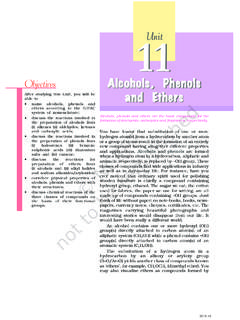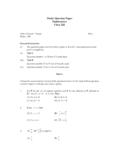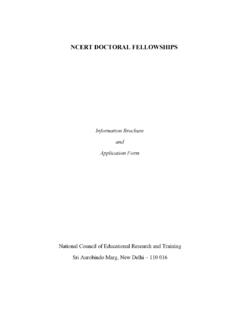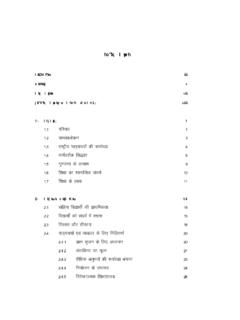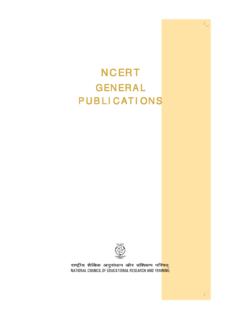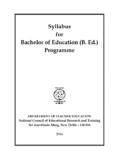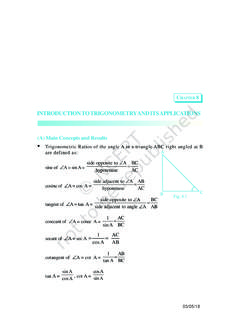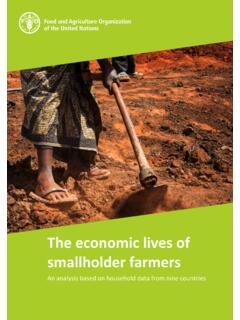Transcription of 19.A Seed Tells a Farmer’s Story - NCERT
1 19. A seed Tells a Farmer's Story I am a small seed ! I am a small bajra seed . I have stayed in this beautiful wooden box since 1940. I want to tell you my Story . This is a long Story but not mine alone. It is also the Story of my farmer Damjibhai and his family. If I do not tell my Story now, it might be too late! I was born in Vangaam in Gujarat. That year there was a good bajra (millet) crop. There was a festive mood in the village. Our area was famous for its grain and vegetables. Each year Damjibhai kept aside some seeds from a good crop.
2 This way our bajra family went on from one generation to another. Good seeds were stored in dried gourd (lauki ) which was coated with mud. But that year Damjibhai himself made a strong wooden box to store us. He put in neem leaves to protect us from insects. He put different seeds in different compartments of the box. That was our beautiful home! In those days Damjibhai and his cousins lived together. It was a large family. Everyone in the village helped each other, even in farming. When the crop was ready and harvested, everyone celebrated together.
3 Oh! Those wonderful days! With big feasts and lots to eat! In the winter, it would be time to enjoy the undhiya (a kind of stew). All the vegetables were put into a clay pot, along with fresh spices. The pot was sealed and kept between hot coals. The vegetables cooked slowly in this special cooker, on the fields. Teacher's Note : Encourage children to talk about their experiences before beginning the chapter. Millet has been used only as an example. The children can be asked to narrate their own observations about changes in crops and vegetables that have taken place in their area.
4 174 Looking Around 2022-23. Oh, I forgot, the pot was placed upside down! That is why the dish was called undhiya or upside down in Gujarati. Undhiya would be eaten with bajra rotis, freshly cooked on the chulha. Oh, what an earthy delicious flavour! Along with that, home-made butter, curd and buttermilk was served. farmers would grow many different kinds of crops grains and vegetables . according to the season. The farmers kept enough for their needs and sold the rest to shopkeepers from the city. Some farmers also grew cotton.
5 At home, family members spun cotton on a charkha (spinning wheel) to make cloth. tell w Are rotis made in your home? From which grains are they made? w Have you eaten roti made from bajra or jowar ? Did you like these? Find out and write w In your house what is done to protect grains and pulses from insects? w Which are the different festivals related to farming, celebrated in different seasons? Find out more about any one such festival and write in your notebook . The name of the festival, in which season is it celebrated, in which states of India, what special foods are made, is it celebrated only at home with the family, or together with many people.
6 W Talk to the elders in your family and find out if there were some special foods cooked earlier that are not cooked any more? A seed Tells a Farmer's Story 175. 2022-23. w Find out about the crops cereals, vegetables, pulses that are grown in your area. Of those, is there anything that is famous across the country? Can you recognise these grains? When times changed Over the years, many changes took place in the village. Some places could get water from the canal. They said the canal brought water from far away where a dam had been built on a big river.
7 Then electricity came. Switch on the button and there was light! People found that only one or two crops, like wheat and cotton, got better prices in the market. So most farmers began to grow only these. Soon we old friends bajra and jowar, and also vegetables were forgotten and dismissed, even from Damjibhai's fields! farmers even began to buy seeds from the market. People said they were new kinds of seeds. So farmers did not need to store seeds from the old crop. Now people in the village cooked and ate together only on very special days.
8 As they ate, they would remember how tasty the food used to be in the past fresh from the fields. When the seeds have changed, how could food ever taste the same! Damjibhai was getting old. His son Hasmukh looked after the fields and the family. Hasmukh was making a lot of money from farming. He rebuilt the old house. He brought new machines for farming. He used an electric motor to pump water. He bought a motorcycle to go to the city easily and also a tractor to plough the field. The tractor could do in a day, what the bullocks would take many days to do.
9 176 Looking Around 2022-23. Hasmukh would say, Now we are farming wisely. We grow only what we can sell in the market at a good price. With profits from our fields we can improve our life. We can make progress.. Lying forgotten in the wooden box, I and the other seeds had our doubts. Is all this really progress? There is no longer any need for seeds like us, and animals like the bullocks. After the tractor has come, even people who worked on the fields, are no longer needed. How will they earn money? What will they live on?
10 Discuss w The bajra seed saw differences in the way Damjibhai and Hasmukh did farming (for example, in irrigation, ploughing, etc). What were these differences? w Hasmukh said, With profits from our fields, we can progress. What is your understanding of progress'? Write w What kind of progress would you like to see in your area? More and more expenses The next twenty years saw even more changes. Without cows and buffaloes, there was no cow dung, to be used in the fields as fertilizer. Hasmukh had to buy expensive fertilizer.
